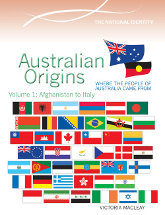Australian Origins: Where the people of Australia came from by Victoria Macleay

Trocadero Publishing, 2012. Volume 1: Afghanistan to Italy. ISBN
9780864271266. Volume 2: Japan to Zimbabwe. ISBN 9780864271273.
Among the key inquiry questions for Year 6 in the history strand of
the Australian National Curriculum are these:
1. Who were the people who came to Australia? Why did they come?
2. What contribution have significant individuals and groups made to
the development of Australian society?
These two books from Trocadero's series The National Identity
are perfect resources for helping students research the answers to
these questions, so they not only have a sound understanding of the
multi-national makeup of our population, but also a solid basis for
the more specialised studies undertaken in history in later years.
Arranged in alphabetical order, there are clear and easily readable
details about each country, its relationship to Australia and a
brief national history which puts the immigration patterns into
context. The information is in easily readable chunks accompanied by
a map, photos and a flag. There's even a pie graph that shows the
number and proportion of each nationality within the overall
population - apparently there are currently 544,171 New Zealand-born
people here, of which I am one! Kiwis are the second largest source
for immigration after those from the UK, which is not surprising.
Because my natural instinct was to look up the stats for my origins,
it would make sense to use these resources in a similar way with
your students. Ask them, 'Were you (or your parents) the first
person from ____ to come to live in Australia?' Given the answer is
probably 'No,' this would provide an opportunity for them to
kickstart their research using these resources and then lead into a
deeper investigation of the history of their home country and why
people choose to migrate. The influence of war is powerful. From
this, a parallel study of the plight of refugees and the
contemporary issue of asylum seekers and 'boat people' could ensue,
as well as comparing how Australians have treated migrants in the
past, such as the shunning of the Chinese during the gold rush, the
White Australia policy, the impact of European immigration after the
war, the current requirements for entry and so on. It would help
students understand how the past influences the present and perhaps
help answer that perennial question about why we need to study
history. Students might then read Marsden's Home and Away
and investigate which country they might flee to, or, if they are
leaving in more convivial circumstances, which country they might go
to and its requirements for entry, work permits and so forth. Is the
grass greener? For a more mathematical slant, students could use the
stats to build a graph of the makeup of Australia's population (an
authentic task for learning pie graphs); perhaps compare it to the
makeup of the school's population and suggest reasons for any
differences such as the tendency for some groups to choose to live
near each other and the implications for this; and then investigate
the wealth of information that is available on the website of the Australian Bureau of Statistics.
Australian Origins is just one in a number of series being published
by Trocadero as it works to provide current, relevant resources to
support the history curriculum. Others include Asia-Pacific
Relations; Asia-Pacific Timelines; Australia Year by Year;
Australian Decades; Defending Australia; Linking the Nation;
and The National Identity (which would also support the Year
6 curriculum). To see the complete list (as well as what's planned)
go to http://www.trocadero.com.au/
and to find those that will meet the needs of a particular year
group go to http://www.intbooks.com.au/pdf-pages/history.php.
As the implementation of the Australian National Curriculum is
rolled out across the country, these are some excellent resources
purposely produced to support it.
Barbara Braxton